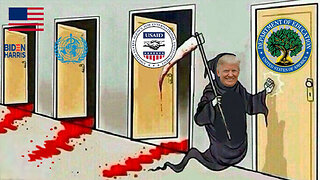Premium Only Content

Home Inspector recommends condensate lines discharge to the ground #homeinspection #hvac #shortvieo
Routing a condensate line from a roof-mounted HVAC (Heating, Ventilation, and Air Conditioning) system to the ground serves several important purposes related to both functionality and safety. Here's why it's important:
Drainage and Water Management: HVAC systems, particularly air conditioners, produce condensation as they cool and dehumidify indoor air. This condensation collects as water, and if not properly managed, it can cause damage to the system and the surrounding area. By routing the condensate line to the ground, excess water is directed away from the HVAC system and the roof, preventing potential water leakage and damage.
Preventing Roof Damage: If condensate were allowed to accumulate on the roof, it could lead to deterioration of roofing materials, increased wear and tear, and potential water penetration. By directing the condensate away from the roof, you protect its structural integrity and prolong its lifespan.
Minimizing Algae and Mold Growth: Condensate lines can be a breeding ground for algae, mold, and other microbial growth due to the presence of moisture. If these contaminants were to accumulate and grow within the line, they could clog the line or even spread into the HVAC system itself. Routing the line to the ground minimizes the risk of such growth.
Preventing Ice Formation: In colder climates, if the condensate were allowed to flow onto the roof and freeze, it could lead to the formation of ice dams and icicles, which can cause roof damage and create safety hazards.
Safety Concerns: If condensate were to drip or flow off the roof, it could pose a slipping hazard for people walking below, especially during rainy or icy conditions. Routing the line to the ground helps prevent potential accidents.
Compliance with Codes and Regulations: Many building codes and regulations require proper drainage of HVAC condensate to prevent water damage and promote safety.
Environmental Considerations: Directing condensate to the ground can also be more environmentally responsible, as it allows for controlled water drainage rather than uncontrolled water runoff from the roof.
To ensure proper routing of the condensate line, it's important to follow manufacturer guidelines, local building codes, and the recommendations of HVAC professionals. The line should be designed with appropriate slope and materials to ensure efficient drainage and prevent clogs. Regular maintenance, such as clearing the line of debris and potential blockages, is also essential to keep the HVAC system functioning optimally and to prevent issues related to poor condensate drainage.
-
 0:52
0:52
Home Inspector Dan
1 year ago $0.01 earnedUnprofessional Roof Repairs Apparent at Home Inspection
32 -
 LIVE
LIVE
Russell Brand
1 hour agoBREAK BREAD EP. 13 - WESLEY HUFF
2,164 watching -
 2:08:22
2:08:22
The Quartering
3 hours ago20,000 Feds QUIT, DOGE Workers Lives At Risk, Trump Vs Dept Of Education, Brie Larson Based & More
31.1K29 -
 DVR
DVR
vivafrei
17 hours agoLive with Enrique Tarrio! Jan. 6 Lawfare ON STEROIDS! Proud Boys & Beyond!
46.7K21 -
 58:19
58:19
Ben Shapiro
3 hours agoEp. 2131 - Trump and Musk Bring The CHAINSAW
46.3K28 -
 1:12:31
1:12:31
Russell Brand
4 hours agoTrump’s Trade Wars: Power Plays and Global Repercussions – SF531
69.9K36 -
 29:57
29:57
The Finance Hub
1 hour agoBREAKING: DONALD TRUMP JR. JUST DROPPED A MAJOR BOMBSHELL!!!
1.05K9 -
 1:57:48
1:57:48
The Charlie Kirk Show
3 hours agoTrump Gets His Cabinet + Killing the USAID Grift + Why Bud Light Collapsed | Frericks | 2.4.2025
136K43 -
 1:21:47
1:21:47
Simply Bitcoin
3 hours ago $1.56 earnedDid America JUST Change The Bitcoin Nation State Race Forever?! | EP 1175
23.4K3 -
 37:13
37:13
Grant Stinchfield
3 hours ago $4.15 earnedBill Gates is Making the Media Rounds Today to Push the Vax and Stop RFK Jr.
26.7K24